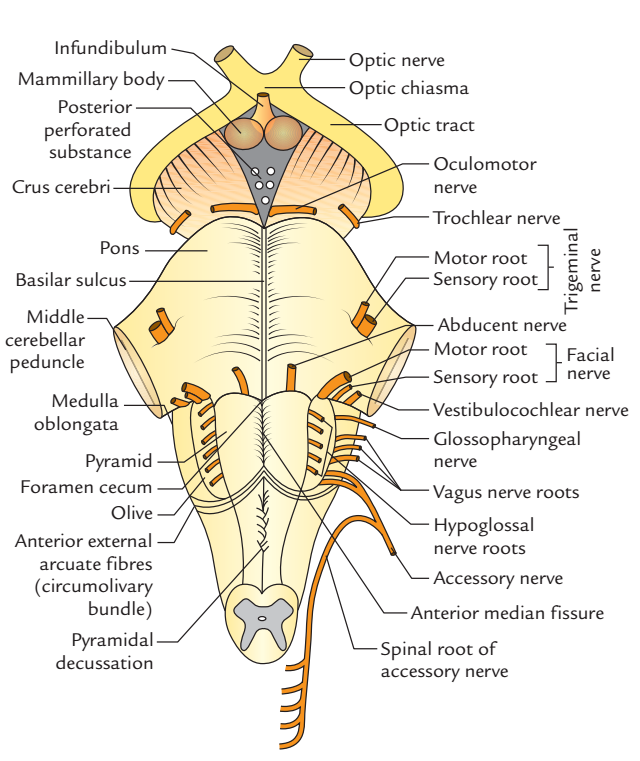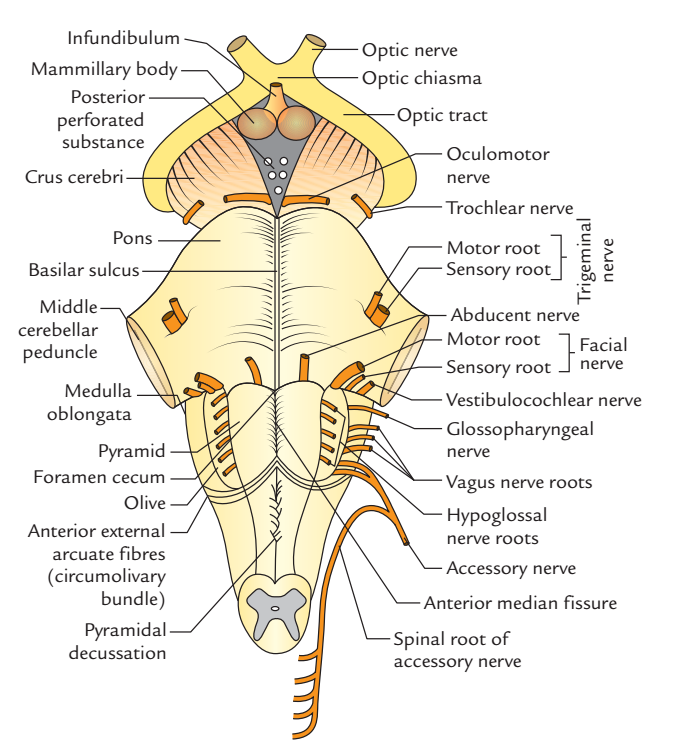The brainstem is the stalklike portion of the brain that joins higher brain centers to the spinal cord. It contains several nuclei that are surrounded by white matter. Ascending (sensory) and descending (motor) axons between higher brain centers and the spinal cord pass through the brainstem. The components of the brainstem include the midbrain, pons, and medulla oblongata.

Anterior aspect of Brainstem
The stalklike part of the brain which connects the forebrain (diencephalon and cerebrum) with the spinal cord is called the brainstem. From below upward, it consists of the medulla oblongata, pons and midbrain.
It is composed of nerve fibres and nerve cells. The nerve cells like spinal cord don’t create one central mass of grey matter; instead majority of them are aggregated to create well defined nuclei. Majority of the fibres in the brainstem are arranged longitudinally in the creation of tracts as in the spinal cord.
The brainstem nuclei have the following 2 types:
- Nuclei of last 10 cranial nerves (i.e., 3rd-12th cranial nerves).
- Other termed nuclei like red nucleus, substantia nigra, pontine nuclei, olivary nuclei, etc
The brainstem includes the diffuse system of cells and fibres named reticular formation along with well-defined tracts and nuclei. A number of the cells of reticular formation create essential centers, viz. cardiac, respiratory, vasomotor etc. They’re of Great Physiological Relevance, in spite of the fact that these centers aren’t anatomically demonstrable.

Posterior aspect of Brainstem
Components of Brainstem
Midbrain
The midbrain is the most superior portion of the brainstem. It is located posterior to the hypothalamus and superior to the pons. It contains reflex centers for head, eye, and body movements in response to visual and auditory stimuli. For example, reflexively turning the head to enable better vision or better hearing is activated by the midbrain.
Pons
The pons lies between the midbrain and the medulla oblongata and is recognizable by its bulblike anterior portion. It consists primarily of axons. Longitudinal axons connect lower and higher brain centers, and transverse axons connect with the cerebellum. The pons also works with the medulla oblongata by controlling the rate and depth of breathing.
Medulla Oblongata
The medulla oblongata is the most inferior portion of the brain, and it is the connecting link with the spinal cord. Descending (motor) axons extending between the brain and the spinal cord cross over to the opposite side of the brain within the medulla oblongata. The medulla oblongata contains three integration centers that are vital for homeostasis:
- The respiratory rhythmicity center controls the basic rhythm of breathing by triggering each cycle of inhale and exhale. It is also involved in associated reflexes such as coughing and sneezing.
- The cardiac control center regulates the rate and force of heart contractions.
- The vasomotor center regulates blood pressure and blood flow by controlling the diameter of blood vessels.

 (56 votes, average: 4.68 out of 5)
(56 votes, average: 4.68 out of 5)